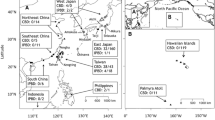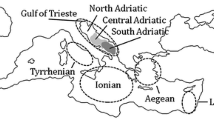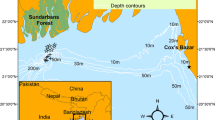Abstract
Despite the openness of the oceanic environment, limited dispersal and tight social structure often induce genetic structuring in marine organisms, even in large animals such as cetaceans. In the bottlenose dolphin, mitochondrial and nuclear DNA analyses have revealed the existence of genetic differentiation between pelagic (or offshore) and coastal (or nearshore) ecotypes in the western North Atlantic, as well as between coastal populations. Because previous studies concentrated on continental margins, we analysed the population structure of bottlenose dolphins in two of the most isolated archipelagos of the North Atlantic: the Azores and Madeira. We analysed 112 samples collected on live animals in the two archipelagos, and nine samples collected on stranded animals in Madeira and mainland Portugal. Genetic analyses consisted in molecular sexing, sequencing of part of the mitochondrial hyper-variable region, and screening of ten microsatellite loci. We predicted that: (1) there is at least one pelagic and one or more coastal populations in each archipelago; (2) populations are differentiated between and possibly within archipelagos. Contrary to these predictions, results indicated a lack of population structure in the study area. In addition, comparison with published sequences revealed that the samples from the Azores and Madeira were not significantly differentiated from samples of the pelagic population of the western North Atlantic. Thus, bottlenose dolphins occurring in the pelagic waters of the North Atlantic belong to a large oceanic population, which should be regarded as a single conservation unit. Unlike what is known for coastal populations, oceanic bottlenose dolphins are able to maintain high levels of gene flow.


Similar content being viewed by others
References
Abe H, Goto M, Pastene LA (2001) Practical use of multiplex fluorescent PCR for cetacean sex identification. Mar Mammal Sci 17(3):657–664
Balloux F, Goudet J (2002) Statistical properties of population differentiation estimators under stepwise mutation in a finite island model. Mol Ecol 11:771–783
Bandelt H-J, Forster P, Röhl A (1999) Median-joining networks for inferring intraspecific phylogenies. Mol Biol Evol 16(1):37–48
Beerli P (2004) Migrate Version 2.0: documentation and program, part of LAMARC. Revised 23/12/2004. Distributed over the Internet: http://evolution.gs.washington.edu/lamarc.html
Belkhir K, Borsa P, Chikhi L, Raufaste N, Bonhomme F (2001) Genetix, a Windows software for population Genetics. Laboratoire Génome, Populations, Interactions, CNRS UPR 9060. Université de Montpellier II, Montpellier, France
Botstein D, White RL, Skolnick M, Davis RW (1980) Construction of a genetic linkage map in man using restriction fragment length polymorphisms. Am J Hum Genet 32:314–331
Buchanan F, Friesen M, Littlejohn R, Clayton J (1996) Microsatellites from the beluga whale (Delphinapterus leucas). Mol Ecol 5:571–575
Cassens I, van Waerebeek K, Best PB, Crespo EA, Reyes J, Milinkovitch MC (2003) The phylogeography of dusky dolphins (Lagenorhynchus obscurus): a critical examination of network methods and rooting procedures. Mol Ecol 12:1781–1792
Connor RC, Wells RS, Mann J (2000) The bottlenose dolphins: social relationships in a fission-fusion society. In: Mann J, Connor RC, Tyack PL, Whitehead H (eds) Cetacean societies. Field studies of dolphins and whales. The University of Chicago Press, Chicago
Crandall KA (1996) Multiple interspecies transmissions of human and simian T-cell leukemia/lymphoma virus type I sequences. Mol Biol Evol 13(1):115–131
DiRienzo A, Peterson AC, Garza JC, Valdes AM, Slatkin M, Freimer NB (1994) Mutational processes of simple-sequence repeat loci in human populations. Proc Nat Acad Sci USA 91:3166–3170
Excoffier L, Laval G, Schneider S (2005) Arlequin ver 3.0: An integrated software package for population genetics data analysis. Evol Bioinformatics Online 1:47–50
Frankham R, Ballou JD, Briscoe DA (2002) Introduction to conservation genetics. Cambridge University Press, Cambridge
Gaggiotti OE, Lange O, Rassmann K, Gliddon C (1999) A comparison of two indirect methods for estimating average levels of gene flow using microsatellite data. Mol Ecol 8(9):1513–1520
Gagneux P, Gonder MK, Goldberg TL, Morin PA (2001) Gene flow in wild chimpanzee populations: what genetic data tell us about chimpanzee movement over space and time. Phil Trans R Soc London B 356:889–897
Gemmel NJ, Akiyama S (1996) An efficient method for the extraction of DNA from vertebrate tissues. TREE 12(9):338–339
Goodman SJ (1997) RST CALC: A collection of computer programs for calculating unbiased estimates of genetic differentiation and determining their significance for microsatellite data. Mol Ecol 6:881–885
Goudet J (2001) FSTAT, a program to estimate and test gene diversities and fixation indices (version 2.9.3). Available from http://www.unil.ch/izea/softwares/fstat.html
Hardy OJ, Vekemans X (2002) SPAGeDI: a versatile computer program to analyse spatial genetic structure at the individual or population levels. Mol Ecol Notes 2:618–620
Hayano A, Yoshioka M, Tanaka M, Amano M (2004) Population differentiation in the Pacific white-sided dolphin Lagenorhynchus obliquidens inferred from mitochondrial DNA and microsatellite analyses. Zool Sci 21:989–999
Hoelzel AR, Hancock JM, Dover GA (1991) Evolution of the cetacean mitochondrial D-loop region. Mol Biol Evol 8(3):475–493
Hoelzel AR, Dahlheim M, Stern SJ (1998a) Low genetic variation among killer whales (Orcinus orca) in the Eastern North Pacific and genetic differentiation between foraging specialists. J Hered 89:121–128
Hoelzel AR, Potter CW, Best PB (1998b) Genetic differentiation between parapatric ‘nearshore’ and ‘offshore’ populations of the bottlenose dolphin. Proc R Soc London B 265:1177–1183
Hoelzel AR, Goldsworthy SD, Fleischer RC (2002) Population genetic structure. In: Hoelzel AR (ed) Marine mammal biology. Blackwell Science Ltd, Oxford, UK
Kimura M, Crow JF (1964) The number of alleles that can be maintained in a finite population. Genetics, 61:893–903
Knutsen H, Jorde PE, André C, Stenseth NC (2003) Fine-scaled geographic population structuring in a highly mobile marine species: the Atlantic cod. Mol Ecol 12:385–394
Krützen M, Valsecchi E, Connor RC, Sherwin WB (2001) Characterization of microsatellite loci in Tursiops aduncus. Mol Ecol Notes 1:170–172
Krützen M, Sherwin WB, Berggren P, Gales N (2004) Population structure in an inshore cetacean revealed by microsatellite and mtDNA analysis: bottlenose dolphins (Tursiops sp.) in Shark Bay, Western Australia. Mar Mammal Sci 20(1):28–47
Marshall TC, Slate J, Kruuk L, Pemberton JM (1998) Statistical confidence for likelihood-based paternity inference in natural populations. Mol Ecol 7(5):639–655
Miller M (2005) Alleles In Space (AIS): Computer software for the joint analysis of interindividual spatial genetic information. J Hered 96:722–724
Möller LM, Beheregaray LB (2004) Genetic evidence for sex-biased dispersal in resident bottlenose dolphins (Tursiops truncatus). Mol Ecol 13:1607–1612
Natoli A, Peddemors VM, Hoelzel AR (2004) Population structure and speciation in the genus Tursiops based on microsatellite and mitochondrial DNA analyses. J Evol Biol 17:363–375
Natoli A, Birkun A, Aguilar A, Lopez A, Hoelzel AR (2005) Habitat structure and the dispersal of male and female bottlenose dolphins (Tursiops truncatus) based on microsatellite and mitochondrial DNA analyses. Proc R Soc London B 272:1217–1226
Natoli A, Cañadas A, Peddemors VM, Aguilar A, Vaquero C, Fernández-Piqueras P, Hoelzel AR (2006) Phylogeography and alpha taxonomy of the common dolphin (Delphinus sp.). J Evol Biol 19:943–954
Nei M, Tajima F, Tateno Y (1983) Accuracy of estimated phylogenetic trees from molecular data II. Gene frequency data. J Mol Evol 19:153–170
Ohta T, Kimura M (1973) The model of mutation appropriate to estimate the number of electrophoretically detectable alleles in a genetic population. Genetic Res 22:201–204
Park SDE (2001) Trypanotolerance in West African cattle and the population genetic effects of selection. PhD dissertation, University of Dublin
Parsons KM, Noble LR, Reid RJ, Thompson PM (2002) Mitochondrial genetic diversity and population structuring of UK bottlenose dolphins (Tursiops truncatus): is the NE Scotland population demographically and geographically isolated? Biol Conserv 108:175–182
Parsons KM, Durban JW, Claridge DE, Herzing DL, Balcomb KC, Noble LR (2006) Population genetic structure of coastal bottlenose dolphins (Tursiops truncatus) in the northern Bahamas. Mar Mamm Sci 22:276–298
Pritchard JK, Stephens M, Donnelly P (2000) Inference of population structure using multilocus genotype data. Genetics 155:945–959
Rice WR (1989) Analysing tables of statistical tests. Evolution 43:223–225
Richard KR, Whitehead H, Wright JM (1996) Polymorphic microsatellites from sperm whales and their use in the genetic identification of individuals from naturally sloughed pieces of skin. Mol Ecol 5:313–315
Ritland K. (2000) Marker-inferred relatedness as a tool for detecting heritability in nature. Mol Ecol 9:1195–1204
Rosel PE, Dizon AE, Heyning JE (1994) Genetic analysis of sympatric morphotypes of common dolphins (genus Delphinus). Mar Biol 119:159–167
Santos RS, Hawkins S, Monteiro LR, Alves M, Isidro EJ (1995) Case studies and reviews: Marine research, resources and conservation in the Azores. Aquat Conserv - Mar Freshw Ecosys 5:311–354
Segura I, Rocha-Olivares A, Flores-Ramírez S, Rojas-Bracho L (2006) Conservation implications of the genetic and ecological distinction of Tursiops truncatus ecotypes in the Gulf of California. Biol Conserv 133:336–346
Sellas AB, Wells RS, Rosel PE (2005) Mitochondrial and nuclear DNA analyses reveal fine scale geographic structure in bottlenose dolphins (Tursiops truncatus) in the Gulf of Mexico. Conserv Genet 6:715–728
Shaw PW, Pierce GJ, Boyle PR (1999) Subtle population structuring within a highly vagile marine invertebrate, the veined squid Loligo forbesi, demonstrated with microsatellite DNA markers. Mol Ecol 8:407–417
Shinohara M, Domingo-Roura X, Takenaka O (1997) Microsatellites in the bottlenose dolphin Tursiops truncatus. Mol Ecol 6:95–696
Silva MA (2006) Population biology of bottlenose dolphins in the Azores Archipelago. Unpublished PhD thesis. University of St Andrews
Silva MA, Prieto R, Magalhães S, Cabecinhas R, Cruz A, Gonçalves JM, Santos RS (2003) Occurrence and distribution of cetaceans in the waters around the Azores (Portugal), Summer and Autumn 1999–2000. Aquat Mammal 29(1):77–83
Slatkin M (1995) A measure of population subdivision based on microsatellite allele frequencies. Genetics 139:457–462
Tamura K, Nei M (1993) Estimation of the number of nucleotide substitutions in the control region of mitochondrial DNA in humans and chimpanzees. Mol Biol Evol, 10:512–526
Templeton AR, Crandall KA, Sing CF (1992) A cladistic analysis of phenotypic associations with haplotypes inferred from restriction endonuclease mapping and DNA sequence data. III. Cladogram estimation. Genetics 132:619–633
Torres LG, Rosel PE, D’Agrosa C, Read AJ (2003) Improving management of overlapping bottlenose dolphin ecotypes through spatial analysis and genetics. Mar Mamm Sci 19:502–514
Valsecchi E, Amos W (1996) Microsatellite markers for the study of cetacean populations. Mol Ecol 5:151–156
Wang JY, Chou LS, White BN (1999) Mitochondrial DNA analysis of sympatric morphotypes of bottlenose dolphins (genus: Tursiops) in Chinese waters. Mol Ecol 8:1603–1612
Wang JY, Chou LS, White BN (2000) Osteological differences between two sympatric forms of bottlenose dolphins (genus Tursiops) in Chinese waters. J Zool Lond 252:147–162
Weir BS, Cockerham CC (1984) Estimating F-statistics for the analysis of population structure. Evolution 38:1358–1370
Wells RS, Rhinehart HL, Cunningham P, Whaley J, Baran M, Koberna C, Costa DP (1999) Long distance offshore movements of bottlenose dolphins. Mar Mammal Sci 15:1098–1114
Wright S (1978) Evolution and the genetics of populations. Vol. 4: variability within and among natural populations. University of Chicago Press, Chicago
Acknowledgements
Authors are very grateful to the Portuguese Foundation for Science and Technology (FCT) for funding the CETAMARH project (POCTI/BSE/38991/01, co-participated by the Community Support Framework - FEDER) as well as S.Q.’s post-doctoral grants (IMAR/FCT- PDOC-006/2001-MoleGen and SFRH/BPD/19680/2004), M.A.S.’s doctoral grant (SFRH/BD/8609/2002) and S.M.’s research assistant grant (CETAMARHII/POCTI/BSE/38991/2001). They acknowledge the EU funded program Interreg IIIb for funding the MACETUS project (MAC/4.2/M10) and R.P. and S.M.’s grants (IMAR/INTERREGIIIb/MACETUS/MAC1/2). IMAR-DOP/UAç is the R&D Unit #531 funded through the pluri-annual and programmatic funding schemes of FCT-MCTES and DRCT-Azores. The authors wish to thank all the students and staff who contributed to the two projects, with special thanks to the skippers (P. Martins, V. Rosa, R. Bettencourt and N. Serpa), whose dexterity greatly helped sample collection. They also acknowledge M. Sequeira (Instituto da Conservação da Natureza, ICN) for providing access to samples of animals stranded along the Portuguese coast, and two anonymous reviewers for useful comments on an earlier version of the manuscript.
Author information
Authors and Affiliations
Corresponding author
Rights and permissions
About this article
Cite this article
Quérouil, S., Silva, M.A., Freitas, L. et al. High gene flow in oceanic bottlenose dolphins (Tursiops truncatus) of the North Atlantic. Conserv Genet 8, 1405–1419 (2007). https://doi.org/10.1007/s10592-007-9291-5
Received:
Accepted:
Published:
Issue Date:
DOI: https://doi.org/10.1007/s10592-007-9291-5




